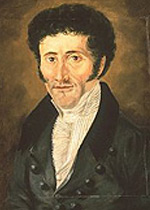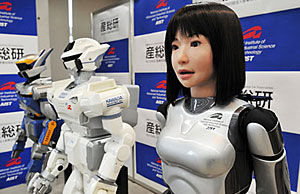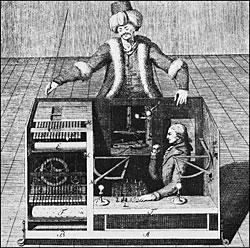Automata 101: Gothic Romance and the Uncanny
Rhonda Knight is an Associate Professor of English at Coker College in Hartsville, SC. She teaches Medieval and Renaissance literature as well as composition courses. This blog will outline her experiences teaching an Honors English Composition course about created entities, beginning with the golem of Jewish legend and continuing through cyborgs, robots, androids, and artificial intelligence.
My goal for this section was to introduce the students to the concept of the uncanny and connect it to humanity’s perception of robots. I also wanted to focus on different types of texts in this section. We read short stories, articles, and essays.
 We began by reading the classic “uncanny” short story: E. T. A. Hoffmann’s “The Sandman,” in which a university student, Nathanael, falls in love with an automaton, Olimpia, that he believes is his professor’s daughter. Sigmund Freud used this story in his famous essay on the uncanny to explain the concept. However, we did not read Freud’s essay because it focuses more on castration anxiety than the uncanny. Instead, we read an older essay on the uncanny by Ernst Jentsch, “On the Psychology of the Uncanny (PDF),” published in 1906. This essay posits that our feelings of the uncanny stem from our inability to determine if a figure is alive or not, which is a good, basic concept for us to use in the class.
We began by reading the classic “uncanny” short story: E. T. A. Hoffmann’s “The Sandman,” in which a university student, Nathanael, falls in love with an automaton, Olimpia, that he believes is his professor’s daughter. Sigmund Freud used this story in his famous essay on the uncanny to explain the concept. However, we did not read Freud’s essay because it focuses more on castration anxiety than the uncanny. Instead, we read an older essay on the uncanny by Ernst Jentsch, “On the Psychology of the Uncanny (PDF),” published in 1906. This essay posits that our feelings of the uncanny stem from our inability to determine if a figure is alive or not, which is a good, basic concept for us to use in the class.
While the reading audience sees this live/not live confusion through the character of Nathanael, another Hoffmann story “The Automata” does a better job in conveying the feeling of the uncanny for everyone. When speaking of the fortune-telling automaton, The Turk, that’s all the rage, one character confesses:
“All figures of this sort,” said Lewis, “which can scarcely be said to counterfeit humanity so much as to travesty it in mere images of living death or inanimate life are most distasteful to me. When I was a little boy, I ran away crying from a waxwork exhibition I was taken to, and even to this day I never can enter a place of the sort without a horrible, eerie, shuddery feeling.
When I see the staring, lifeless, glassy eyes of all the potentates, celebrated heroes, thieves, murderers, and so on, fixed upon me, I feel disposed to cry with Macbeth: ‘Thou hast no speculation in those eyes / Which thou dost glare.’ And I feel certain that most people experience the same feeling, though perhaps not to the same extent. For you may notice that scarcely anyone talks, except in a whisper, in waxwork museums. You hardly ever hear a loud word. But it is not reverence for the Crowned Heads and other great people that produces this universal pianissimo; it is the oppressive sense of being in the presence of something unnatural and gruesome; and what I detest most of all is the mechanical imitation of human motions.”
I wanted to counter these Hoffmann stories with an activity that allowed the students to experience a bit of the uncanny rather than search for it in Hoffmann’s dense, gothic prose. I gave them the assignment to watch several videos of robots and write a response that explained why they found a certain one the most uncanny. I sent them to this Creepiest Robots web page at the Huffington Post. (I had them watch the videos numbered 1, 17, 22, and 23, although plenty of them are uncanny.)
While each one of the four robots had one student choose it as the most uncanny, numbers 1 and 17 were the robots that the students wrote about the most. The class discussion was lively as each student defended his or her choice and asked the other students questions about theirs.
Now that the students had a better grasp of the uncanny, we read “The Uncanny Valley” (1970) by roboticist Masahiro Mori. He argues that robots, androids, and cyborgs that are too human-like in appearance fall into an uncanny valley in human perception. He recommends that the creators of these machines avoid making them resemble people too much. You can see his famous graph that depicts the uncanny valley and an interesting slideshow at this blog.
 We followed “The Uncanny Valley” with an article from The New Scientist, “What Puts the Creepy into Robot Crawlies? (PDF)” (2007), by Jim Giles. This article is valuable because it summarizes Mori’s argument and then presents newer research. It explains that researchers, Thierry Chaminade and Ayse Saygin of University College London, use brain scans to observe the parts of subjects’ brains that are activated when they see a human, a humanoid robot, and a mechanical robot performing similar human actions, such as picking up a cup. The researchers believe the feeling of the uncanny can be found in the specific areas of the subjects’ brains that are activated only when the humanoid robot is observed.
We followed “The Uncanny Valley” with an article from The New Scientist, “What Puts the Creepy into Robot Crawlies? (PDF)” (2007), by Jim Giles. This article is valuable because it summarizes Mori’s argument and then presents newer research. It explains that researchers, Thierry Chaminade and Ayse Saygin of University College London, use brain scans to observe the parts of subjects’ brains that are activated when they see a human, a humanoid robot, and a mechanical robot performing similar human actions, such as picking up a cup. The researchers believe the feeling of the uncanny can be found in the specific areas of the subjects’ brains that are activated only when the humanoid robot is observed.
The last texts in this section make an interesting pair: Edgar Allan Poe’s 1836 essay, “Maelzel’s Chess Player” and F. Gwynplaine MacIntyre’s story, “The Clockwork Horror,” that fictionalizes Poe’s essay. In “Maelzel’s Chess Player,” Poe, as a writer for Richmond’s Southern Literary Messenger, investigates a traveling automaton show, featuring the Turk, which played chess in exhibition matches. His essay debunks the Turk and explains how a human is hidden in the elaborate box that houses the false automaton. My purpose in assigning this essay was to expose the students to the idea that robot-like automata were not uncommon exhibitions at the time that Hoffmann and his contemporaries were writing about them in fiction.
In fact, the automaton that Poe saw in 1836 was probably Hoffmann’s inspiration for his Turkish fortune-teller. The same machine had been touring Europe and America since the late 1700s. Jane Irwin has created a fabulous web comic about the history of the Turk, Clockwork Game: The Illustrious Career of a Chess-Playing Automaton. I’ve just started reading it. Too bad I didn’t know about the comic when I was teaching this section. I’ve put it on the course website.
 Poe’s essay tells his readers that he commandeers the audience after the Turk’s game and explains how the box contains a hidden chess player and uses magician’s tricks to hide the player during Maezel’s lengthy exposure of the cabinet. Here we glimpse the writer who will create C. Auguste Dupin and his stories of ratiocination. Since Poe’s prose is dense and a bit hard to get through, I also assigned MacIntyre’s story to give the students an account of Poe’s reasoning in a more accessible form. MacIntyre did some research for this horror story and was able to fill in some blanks that Poe left out.
Poe’s essay tells his readers that he commandeers the audience after the Turk’s game and explains how the box contains a hidden chess player and uses magician’s tricks to hide the player during Maezel’s lengthy exposure of the cabinet. Here we glimpse the writer who will create C. Auguste Dupin and his stories of ratiocination. Since Poe’s prose is dense and a bit hard to get through, I also assigned MacIntyre’s story to give the students an account of Poe’s reasoning in a more accessible form. MacIntyre did some research for this horror story and was able to fill in some blanks that Poe left out.
I’m happy with the way this section turned out. The students read several different types of texts–from difficult nineteenth-century authors to an article from a popular science magazine–examined the uncanny from different perspectives, and gained some historical context. They’ll get more history in the next section when we begin with early-twentieth-century robots in R. U. R. and Metropolis.



















 Full Details
Full Details


5 Comments
Sounds like a fascinating course! I look forward to reading a re-cap of the next section.
Von Kempelen’s chess machine is an interest I’d like to learn more about when I get the time (fat chance). I read part of a novel called The Chess Machine by Robert Lohr about a dwarf chess master hired to work the machine that was interesting for a while, but felt bland after a while, probably due to the translation. I think there are some salient similarities between this discussion of physical automata and constructs in contemporary video games and related software. As graphics continue to get better, edging closer to complete "realism," they often plummet into the uncanny valley and just seem weird (for me, it’s usually the awkward position of the teeth or the movement of the arms that do it, but for many people it’s the eyes), so games with more popular aesthetic designs seem (to me) to be those with "stylized realism" that intentionally exaggerates features to sidestep that uncanny valley. I kept thinking of the cyborgs (if you can call them that) in Pacigalupi’s The Windup Girl when reading this post, particularly after seeing that realistic dental practice robot! I also thought about how Turing’s AI test, and even Searle’s "Chinese Room" thought experiment, depend on not being able to see or touch the thing sending you the information to prove it’s intelligent and worthy of being treated like a human being at least. I’d guess that sight is the most powerful trigger of the uncanny, but it would be interesting to see how the other senses played in it as well. Thanks for the post!
Deven Science, Thanks.
Mattastrophic, me, too. I just learned about the Turk. There seem to be several non-fiction books out about it. If you look up the webcomic that I mention, the author gives a bibliography. In class we talked a bit about the uncanny and CGI, but we mostly discussed the CGI in movies like Beowulf and Polar Express. I have not read The Windup Girl, so I guess that I should add it to my list. More in another post. I’m having some difficulty posting today. I must have had a special character that I could not see lurking in my previous attempt.
Okay, here I am again to finish. Interesting thoughts about the connection between uncanny and sight. I told the students that out of sync video dubbing causes me to have uncanny feelings, the combination of sight and sound. I think that the loss of sync reminds us of the "production" involved in creating what we see. We are able to suspend disbelief only so far: we want to think (a) that we are watching a slice of reality or (b) that we are watching the scene exactly as it was captured by the camera rather than a video/film that has been deconstructed, edited, and reconstructed. Maybe I’m widening the meaning of uncanny too much, but I do get that "eerie, shuddery feeling" that the character in Hoffmann’s "Automata" describes.Thanks for your comments.
Sorry, the comment form is closed at this time.